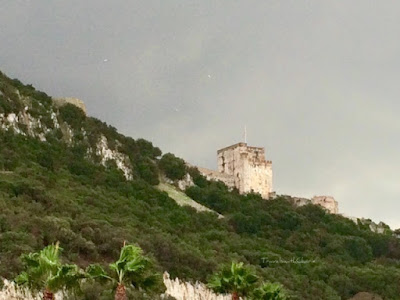 |
| Rock of Gibraltar |
The train service between Ronda and Algeciras is limited. In Algeciras we took the bus to Gibraltar. We knew we had a tight window for sightseeing so we could make it back to Algeciras in time to catch the last train to Ronda. And the rain didn't help at all. But we managed.
The approach to La Línea de la Concepción on the Spanish side of the peninsula gave us the best glimpse of the 426 meter high limestone rock towering behind the beach and harbor. The Rock was a spectacular sight to behold!
 |
| Crossing the runway |
We waited for an EasyJet flight to take off before the security barricade was lifted and we could safely cross the runway to get to the city center. Cars, buses, trucks and people moved quickly across the tarmac. In the distance we could see a lot of new construction. Gibraltar's area size is only 2.6 square miles but it's home to some 32,000 people. It's pretty crowded.
 |
| The runway of the Gibraltar International Airport |
This is an active runway and as it is open to the sea on both ends, it acts like a wind tunnel. With intermittent rain showers during our visit, we got a little wet. The wind rendered our umbrella useless.
 |
| Winston Churchill Avenue |
There is usually a queue of vehicles waiting to cross the runway. It's best to leave the car on the Spanish side of the border and walk across the tarmac. Buses going up to the center of town run a regular schedule if walking is not an option.
 |
| Tower of Homage |
The 14th century Moorish castle complex can be glimpsed from Main Street. What's left are the Tower of Homage and the Gatehouse which were rebuilt in 1333 when the Moors reconquered Gibraltar from Spain and occupied it for the next 129 years.
 |
| Phone booth |
What can be more British than this iconic red phone booth? Remember when we used to close the door of the booth to talk in privacy?
 |
| Tropical Foliage |
How to get there from Ronda, Spain;
Our whirlwind trip to Gibraltar from Ronda was achieved using a combination of train and bus to transport us. The Altaria is not a fast train and we left Ronda at 9:18 a.m. and were in Algeciras by 11 a.m. The bus station in Algeciras is conveniently located across the street from the train station. We waited a few minutes to board the bus to La Línea which is a short walk from Gibraltar. After showing our passports to a Customs Officer, we were waved through. Outside the Customs office are tour operators offering a variety of sightseeing opportunities around the peninsula. There is a bus stop a few meters outside the Customs building on Winston Churchill Avenue for visitors who wish to take the red bus across town.
*****
Images by TravelswithCharie